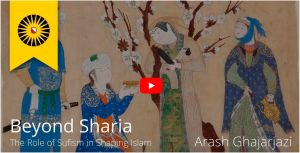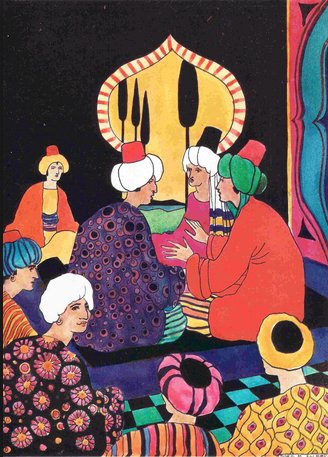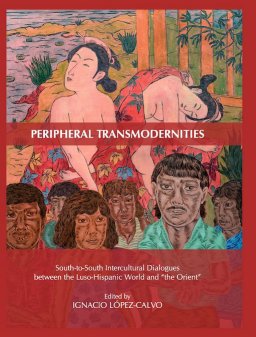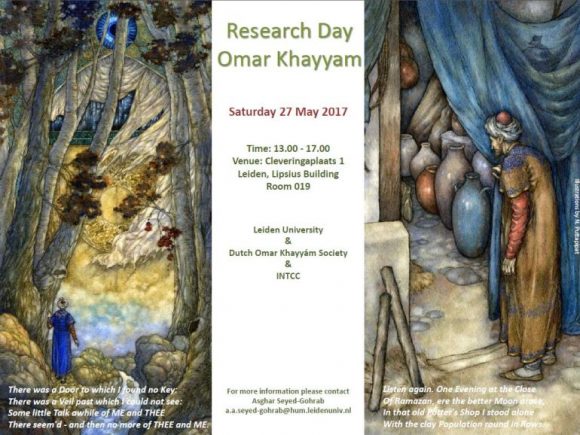 Centuries before the Enlightenment in the Christian world (1685 – 1815), secularity was present in the Persian cultural area. As a postdoc, Arash Ghajarjazi, associated with the Beyond Sharia project of Utrecht University, does research on medieval non-conformist ideas and the emergence of secularity in the Persian cultural area. He examines the work of various Persian intellectuals who criticised Islam, including Omar Khayyam. His thinking can sometimes be called downright atheistic and his quatrains are still world-famous. Ghajarjazi discusses his findings in an interview.
Centuries before the Enlightenment in the Christian world (1685 – 1815), secularity was present in the Persian cultural area. As a postdoc, Arash Ghajarjazi, associated with the Beyond Sharia project of Utrecht University, does research on medieval non-conformist ideas and the emergence of secularity in the Persian cultural area. He examines the work of various Persian intellectuals who criticised Islam, including Omar Khayyam. His thinking can sometimes be called downright atheistic and his quatrains are still world-famous. Ghajarjazi discusses his findings in an interview.
Category Archives: Research
Orlando Greenwood
Danton O’Day has sent a message that he has come across some information revealing that Orlando Greenwood, a well-known British artist, has illustrated specific quatrains from FitzGerald’s first version of the Rubaiyat. Most likely these pictures were not published, since they were done around the start of WWI, but there may be several copies of them out there. If someone has some of these or if they have any other information about them, please let him know (email: danton.oday@utoronto.ca).
Omar Khayyám Research Day
The Nederlands Omar Khayyám Genootschap (Dutch Omar Khayyám Society) is planning an Omar Khayyám Research Day, May 27, 2017. The event will take place in Leiden, in co-operation with Leiden University and Iran Netherlands Trade and Cultural Center.
PROGRAMME
13.00 Words of Welcome
13.15 Bill Martin & Sandra Mason
The Rubaiyat of Omar Khayyam in the West
How Edward FitzGerald & Edward Cowell made it popular
14.00 Nasrollah Pourjavady
Omar Khayyam’s Idea of Being in His Quatrains
14.45 Break
15.15 Asghar Seyed-Gohrab
Transgressing the Law: Khayyam and his Antinomian Views
15.45 Jos Coumans
Comparative tables of the Calcutta & Bodleian quatrains
16.15 Rokus de Groot
Musical approaches to Omar Khayyâm’s Rubâiyât in the Netherlands
17.00 Concluding remarks
For more details on time and location, see the poster, or contact Asghar Seyed-Gohrab on a.a.seyed-gohrab@hum.leidenuniv.nl.
Gilbert James: illustrator of The Rubáiyát
 One of the early illustrators of the Rubáiyát of Omar Khayyám was Gilbert James (1865-1941). His work can be found in numerous editions and reprints of The Rubáiyat, and a number of his illustrations have been issued as post cards as well. Although this indicates that his work was rather popular in his days, very little is known about the artist himself.
One of the early illustrators of the Rubáiyát of Omar Khayyám was Gilbert James (1865-1941). His work can be found in numerous editions and reprints of The Rubáiyat, and a number of his illustrations have been issued as post cards as well. Although this indicates that his work was rather popular in his days, very little is known about the artist himself.
In a recently published document however, Bob Forrest reports the findings of his research into the artist and his work, particularly his Rubáiyát illustrations. They appeared for the first time in a magazine ‘The Sketch’ (1896) and in book form in 1898, published by Smithers (1898) as Fourteen Drawings illustrating Edward FitzGerald’s Translation of the Rubaiyat of Omar Khayyam.
This highly important document is available on Bob Forrest’s website: http://bobforrestweb.co.uk/The_Rubaiyat/N_and_Q/Gilbert_James/Gilbert_James.htm
The Rubáiyát from the Bodleian ms.
 The new website called Concordances of the Rubáiyát, is a project I have been working on for a couple of years. The website presents the quatrains from the Bodleian manuscript of the Rubáiyát that FitzGerald used for his famous translation. Together with the Persian text, taken from Heron-Allen’s edition of 1898, a number of corresponding translations is listed underneath each quatrain.
The new website called Concordances of the Rubáiyát, is a project I have been working on for a couple of years. The website presents the quatrains from the Bodleian manuscript of the Rubáiyát that FitzGerald used for his famous translation. Together with the Persian text, taken from Heron-Allen’s edition of 1898, a number of corresponding translations is listed underneath each quatrain.
You will also find a number of (sortable) tables of corresponding quatrains, based on the tables in studies and publications by Anet (1957), Arberry (1949 and 1952), Heron-Allen (1898), Thompson (1906) and Tirtha (1941). More tables will follow.
Finally there is a list of translations from a number of authors whose quatrains have a correspondence to the Bodleian manuscript.
Work on the project is still in progress, and I would highly appreciate to receive comments, corrections and suggestions.
Recent papers and articles
 A couple of recent articles show that there is still a living interest in Khayyám’s rubáiyát, and that there is wide range of subjects and aspects left to be studied.
A couple of recent articles show that there is still a living interest in Khayyám’s rubáiyát, and that there is wide range of subjects and aspects left to be studied.
Rebecca Mueller, graduate student at Indiana University, published a paper “Balkan Rubaiyat”, in which she presents two case studies of post-Ottoman translation. The studies concern the translations by Safvet-Beg Bašağić (1870-1934), Omer Chajjam. Rubaije published in 1920, and by Theofan Stylian Noli (1882-1965), a version in Albanian, in 1926. Mueller’s aim is to discuss how these translations can be seen in the context of Western as well as Eastern orientation of Bosnian or Albanian indentity-formation in that period.
Balkan Rubaiyat. The post-Ottoman polysystem between East and West. Rebecca Mueller.
Online available at: http://www.academia.edu/7868153/Balkan_Rubaiyat_The_Post-Ottoman_Polysystem_Between_East_and_West.
D.P. May, from the Mathematics Department, Black Hills State University, Spearfish, takes a mathematical view on the Rubáiyát: how can graph theory be used to explore the connections between the various quatrains in FitzGerald’s translations.
Complete graphs in the Rubáiyát. D.P. May. Journal of Mathematics and the Arts, 8 (2014), nrs. 1-2, 59-67. DOI: 10.1080/17513472.2014.939526.
Rebecca Weston raised the question whether readers of Chinese and Persian poetry, notably by Li Bo, Khayyám or Hafez, should read between the lines when themes like ‘drunkenness’ or ‘drinking of wine’ occur. Drunkenness is not only a state of physical intoxication, but also refers to a state of spiritual enlightenment, and apart from the view that the reader takes in this discussion, Weston concludes that this unquestionably is an issue for “lengthy debate”.
Implications of Mystic Intoxication in Chinese and Iranian poetry. Rebecca Weston. The Undergraduate Historical Journal, 1 (2014), nr. 1.
Online available at: https://escholarship.org/uc/item/56m0j6zp
The recent translation into Dutch by Paul Claes, Omar Chajjaam. Kwatrijnen (2010) is discussed by Benoît Crucifix, student at Université catholique de Louvain. In this article, the author looks at quatrain nr. XI, to demonstrate the principles and theoretical ideas in Claes’ translation.
Woestijn waar ik dit paradijs aan dank. Claes vertaalt FitzGerald vertaalt Chajjaam. Benoît Crucifix. Filter, 21 (2014), nr. 2.
Abstract
And finally, Reza Taher-Kermani presents new insights into FitzGerald’s translation practice, to substantiate the claim that FitzGerald succeeded in transmitting an authentic Persian spirit in his Rubáiyát.
FitzGerald’s Anglo-Persian Rubáiyát. Reza Taher-Kermani. Translation and Literature, 23 (2014), 321-334. DOI:10.3366/tal.2014.0162
Omar in Spanish-America
 In “Otras inquisiciones, 1937-1952” (1952) the famous Argentinian author Jorge Luis Borges published a short essay “El enigma de Edward FitzGerald”, in which he suggests that Omar might be reincarnated in Edward FitzGerald. In his earlier work “Inquisiciones” (1925) Borges also wrote a short essay called “Omar Jaiyám y FitzGerald” in which he refered to a translation to Spanish of a number of quatrains of Omar Khayyám by his father, Jorge Guillermo Borges (1874-1934). This reference to his father was left out in the later Inquisiciones of 1952.
In “Otras inquisiciones, 1937-1952” (1952) the famous Argentinian author Jorge Luis Borges published a short essay “El enigma de Edward FitzGerald”, in which he suggests that Omar might be reincarnated in Edward FitzGerald. In his earlier work “Inquisiciones” (1925) Borges also wrote a short essay called “Omar Jaiyám y FitzGerald” in which he refered to a translation to Spanish of a number of quatrains of Omar Khayyám by his father, Jorge Guillermo Borges (1874-1934). This reference to his father was left out in the later Inquisiciones of 1952.
Borges Jr.’s later essay may be familiar to the Omar devotees, but that his father was one of the first to translate Khayyám’s quatrains to Spanish is probably new to many of us. We learn more about early Spanish translations in a chapter “Omar Khayyam’s Epicureanism” by Axel Gasquet (Université de Blaise Pascal, Clermont-Ferrand), with the subtitle “The Spanish translations of Rubaiyats”. The author gives a brief summary of a number of translations published in Spanish-American countries. Here, and in the Phillipines twelve translations of the Rubáiyát were issued in twenty-six years. The first translation was by Juan Dublan (Mexico, 1904), followed by Gregorio Martinez Sierra (Madrid, 1907), and finally by Francisco Propata (Paris, 1930).
Four works are discussed more in detail: the versions by Dublan, Muzzio Sáenz-Peña, González and Bernabé. Gasquet describes the socio-cultural conditions of their time, and the sources of their work. He also shows how the hedonist-mystic debate played a role in these works.
Though the analysis is limited to only four translations, the chapter is rather interesting as it informs us about a number of translations that are not all in Potter, and that are probably unknown to many of our readers. One reason might be that these unknown translations were published in magazines or journals, or were part of anthologies.
The twelve translations that are refered to are:
- DUBLAN, Juan. “Ruba’iyyat” de Omar Khayyam. Mexico, Caranza, 1904. (online at archive.org) (Potter 509)
- SIERRA, Gregorio Martinez. Los Rubayata de Omar Khayyam de Naishapur. In: ‘Renacimiento’, March 1907, pp. 89-104 (Potter 510)
- MUZZIO SÁENZ-PEÑA, Carlos. Rubaiyat de Omar-al-Khayyam. La Plata, Sesé, 1914.
- CASTELLOT, José. Rubaiyat de Omar Khayyam. Prologo por Jose Juan Tablada. New York, [s.n.], 1918. (Potter 584)
- BORGES, Jorge Guillermo. (Sixty-two quatrains). In: ‘Proa’, 1924. (A smaller number of quatrains was published in ‘Gran Guignol’, 1920.
- EULATE SANJURJO, Carmela. Rubayyat. In: ‘Antología de poetas orientales’. Barcelona : Editorial Cervantes, 1921.
- GUIRAO, Pedro. Omar Khayyam. Las mejores poesías (líricas) de los mejores poetas. XXXI. Barcelona, Cervantes, 1922 (Potter 517)
- BERNABÉ, Manuel. Rubáiyát de Omar Khayyam. Manilla, Imp. de la Vanguardua, 1923.
- GARCIA CALDÉRON, Ventura. Omar Kheyyam. Rubaiyat. San José de Costa Rica, El Convivio, 1925.
- GONZÁLEZ, Joaquín V. Rubáiyát de Omar Khayyám. Buenos Aires, Roldán, 1926. (Potter 518)
- PROPATO, Francisco. Ensayo crítico sobre Las Rubáiyát de Umar-i-Khayyám. Acompañado de la versión castellana y de notas. Paris, Bourdon, 1930.
Peripheral Transmodernities : South-to-South Intercultural Dialogues between the Luso-Hispanic World and “the Orient.” Ed. by Ignacio Lopez-Calvo. Newcastle upon Tyne, Cambridge Scholars Publishing, c2012. ISBN 9781443837262.
Read about about this book on: http://ignaciolopezcalvo.blogspot.nl/2012/02/peripheral-transmodernities-south-to.html
A number of Borges’s rubaiyat can be found at: http://cronicasdeotros.blogspot.nl/2010/03/del-poema-de-omar-jaiyiam-omar-khayyam.html
